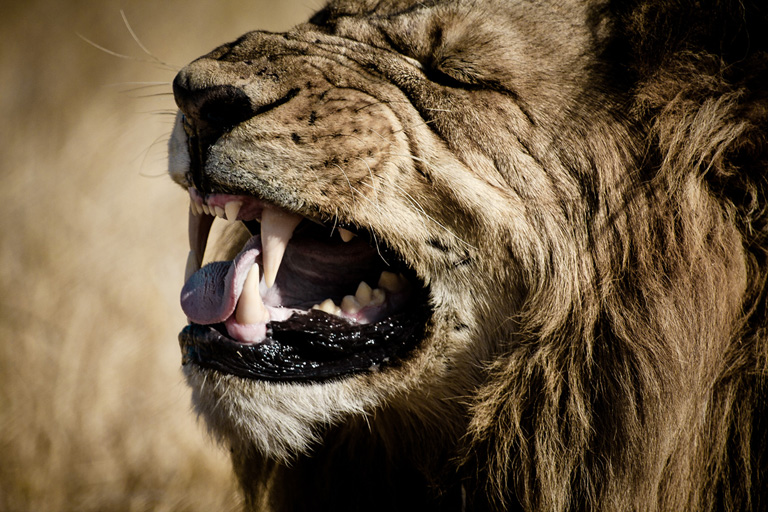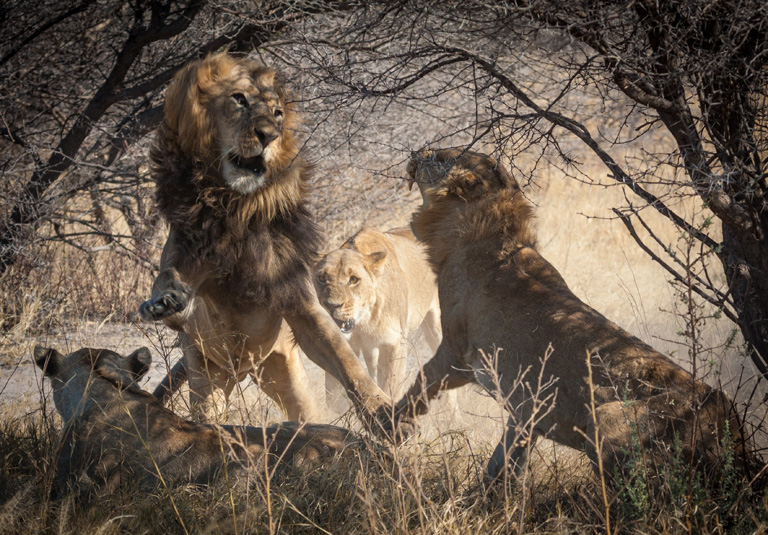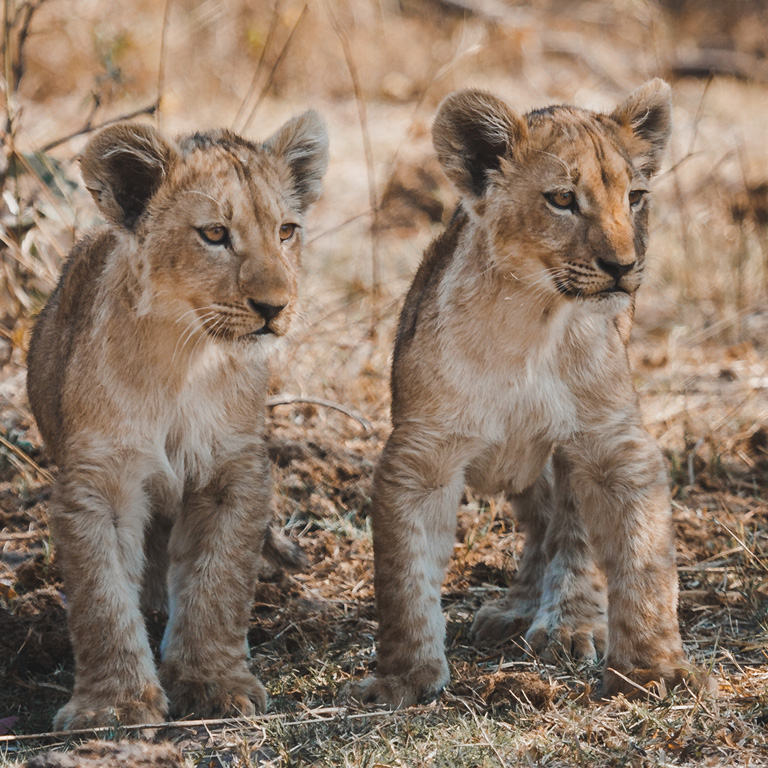- A discovery of two genetically distinct African lion populations adapted to habitat, not humans.
- Sometimes the patterns we see in populations of conservation concern may not be caused by people. Instead, they may in fact be a result of evolutionary adaptation helping one group of animals improve their chances of survival in a particular habitat type. It is crucial that we are aware of such adaptations.
- If we dilute this unique adaptation through haphazardly moving animals to mitigate what we erroneously think is human-caused fragmentation, we may inadvertently reduce a species ability to survive in a changing climate.
- This post is a commentary. The views expressed are those of the author, not necessarily Mongabay.
The lion. The king of the jungle. It’s certainly one of Africa’s (if not the world’s) most iconic animals. It is on the ‘must see’ list of just about every person that heads to East or southern Africa for safari, and stars in an array of nature documentaries, films, and books. Nestlé even named a chocolate bar after the animal.
Despite this, and possibly because of their ubiquity in our media, most people would be surprised if you told them that lions are really not doing very well. Their numbers have declined from an estimate of over 1,000,000 in the nineteenth century to about 30,000 individuals today.
The biggest cause of the decline in lion numbers is simply a loss of space for them to live. As humans make increasing technological advancements to accommodate the needs of our exploding population, we encroach on the remaining areas of wilderness, dividing and splitting the parcels of habitat into smaller and less-connected refugia. The remaining fragments contain limited resources and are unable to support as many individuals. In addition, the remaining small and isolated populations risk inbreeding because closely related individuals are no longer able to disperse and end up mating together, exerting yet more pressure on vulnerable populations.

Photo © Simon Dures 2012.
Given the irrefutable damage that humans are having on the environment, it is very easy to assume that all population fragmentation is caused by humans. As conservation practitioners, this is something that we aim to address by reconnecting populations and even, in dire situations, by relocating individuals from one population to another to reduce levels of inbreeding. But what if we are wrong? What if, in our arrogance, we assume a population has been fragmented by people when in fact it is a purely natural phenomenon? If such a mistake is made, natural adaptations to unique habitats could easily become unbalanced and reduce a populations’ ability to thrive.
Botswana’s Okavango Delta is a truly magical place. An oasis of green in the sands of the Kalahari Desert. It also has a sizable lion population and forms part of a much wider conservation region known as the Kavango-Zambezi Transfrontier Conservation Area, or KAZA, one of the last lion strongholds in Africa. There is an extensive network of fences surrounding much of the Okavango Delta, dividing it from the vast plains of the Central Kalahari Game Reserve and Makgadikgadi Pans National Park. These fences are designed to stop the movement of ungulates, particularly buffalo, into the cattle ranching areas, facilitating disease-free status for beef export. But they are also accused of preventing the movement of many other species, including lions. Further, when predators such as lions do encroach on cattle farming areas, they are likely not to survive the inevitable conflict.
To assess exactly where lions can and cannot disperse across Botswana’s landscape, we turned to genetics to investigate whether fragmentation existed across the population. If found to be present, we aimed to determine what factors might be causing it. The traditional method would have been the use of satellite collars; however, they are expensive and there is a good chance an individual we collar may not disperse. By using genetics, we can take a small tissue sample from lots of different lions. From these samples we extract DNA, look at relatedness between individuals, and can then calculate how lions are dispersing across the landscape. We can also examine what elements of the landscape, such as habitat type, fences, cattle ranches, and waterways, are preventing or facilitating any dispersal.

Eviction. Photo © SimonDures.com/ZSL.
The work has found that the lions are indeed fragmented. We discovered two genetically distinct populations of lions in the region: the so-called ‘wetland lions’ residing in the wetland habitat in the Okavango Delta, and a ‘dryland lions’ group living in the semi-arid habitat of the Kalahari Desert. Between these two populations, only very limited dispersal exists. However, when we looked at factors driving this reduced dispersal, we found that it is not fences, cattle ranching, or any other human element of the landscape preventing movement — it is, in fact, the difference in habitat type. Simply, lions that come from a wetland landscape do not like traveling to a desert and vice versa, and this difference would have evolved long before the influence of humans became as strong as it is today.
Perhaps this is not surprising; if a lion has learned to hunt in the plentiful, prey-rich Okavango, it may not know how to survive in the dry Kalahari. Conversely, learning to hunt in the open Kalahari grasslands does not equip a lion with the knowledge to hunt buffalo through water. Most importantly, this work teaches us that sometimes the patterns we see in populations of conservation concern may not be caused by people. Instead, they may in fact be a result of evolutionary adaptation helping one group of animals improve their chances of survival in a particular habitat type. It is crucial that we are aware of such adaptations. If we dilute this unique adaptation through haphazardly moving animals to mitigate what we erroneously think is human-caused fragmentation, we may inadvertently reduce a species ability to survive in a changing climate. It is such diversity which allows a species to withstand pressures, be they from a changing climate, a novel disease, or shrinking populations.
While our finding suggests that Okavango/Kalahari lion fragmentation is not driven by human actions, it does not mean that people are not having an impact — it simply means the differences between the wetland lions and the dryland lions is currently bigger that any differences caused by human changes to the landscape. If we are not careful, this could change. Such natural differences need to be preserved. It is not uncommon for lions to be moved, both within Botswana and indeed around the African continent, and this risks unbalancing the subtle but important levels of adaptation that have evolved to better survive in unique environments. Such diversity and uniqueness must be preserved if species such as lions are to thrive long into the future. It is essential we understand the nature of the populations we are working with before we make conservation decisions.

Cubs. Photo © SimonDures.com/ZSL.
Dr. Simon Dures is currently an independent consultant working on projects to improving local capacity to investigate wildlife crime, such as poaching, across Africa. This research pertains to his PhD studies while at international conservation charity ZSL’s (Zoological Society of London) Institute of Zoology and Imperial College London.
Article published by Mike Gaworecki
https://news.mongabay.com/2020/03/some- ... f-77211477


